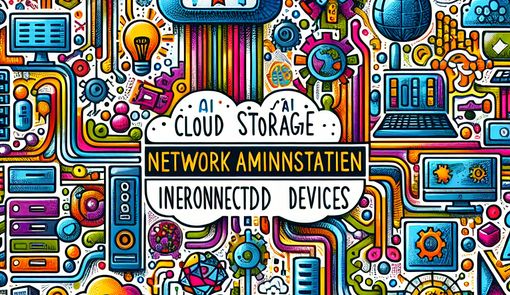Network Administrator
A Network Administrator is responsible for overseeing and maintaining an organization's computer networks, ensuring that network hardware and software are working smoothly, and handling any network-related issues.

Top Articles for Network Administrator
Sample Job Descriptions for Network Administrator
Below are the some sample job descriptions for the different experience levels, where you can find the summary of the role, required skills, qualifications, and responsibilities.
Junior (0-2 years of experience)
Summary of the Role
We are seeking a technically proficient and detail-oriented Network Administrator who is just starting their career in network management and maintenance. As a junior Network Administrator, you'll be supporting and maintaining network infrastructure, ensuring stable and secure communication within the company.
Required Skills
- Knowledge of network security practices and anti-virus programs.
- Ability to quickly learn new or unfamiliar technology and products using documentation and internet resources.
- Ability to work with all levels of staff within and outside of IT and outside the organization.
- A willingness to work flexible hours.
- Strong interpersonal skills and ability to effectively communicate with teams across the entire organization.
- Patient and professional demeanor, with a can-do attitude.
Qualifications
- Bachelor's degree in Computer Science, related field, or equivalent experience.
- Basic understanding of networking concepts (e.g., TCP/IP, LAN/WAN, DHCP, DNS, VPNs).
- Familiarity with network diagnostic, monitoring, and analysis tools (e.g., SolarWinds network tools).
- General knowledge of IT infrastructure and network hardware.
- Ability to think through problems and visualize solutions.
- Good analytical and problem-solving skills.
Responsibilities
- Perform routine network maintenance and system upgrades including service packs, patches, hot fixes, and security configurations.
- Monitor network performance (availability, utilization, throughput, goodput, and latency) and test for weaknesses.
- Set up user accounts, permissions, and passwords.
- Resolve problems reported by end-user.
- Define network policies and procedures.
- Specify system requirements and design solutions.
- Research and make recommendations on server system administration.
Intermediate (2-5 years of experience)
Summary of the Role
As a Network Administrator, you will be responsible for maintaining the computing environment by identifying network requirements, installing upgrades, and monitoring network performance. You will play a pivotal role in ensuring the network's health, security, and ongoing ability to support organizational goals.
Required Skills
- Working knowledge of current communications devices and protocols, server and desktop technologies.
- Ability to manage multiple projects, activities and tasks simultaneously.
- Highly self-motivated and directed, with keen attention to detail.
- Proven analytical and problem-solving abilities.
- Strong interpersonal, written, and oral communication skills.
- Able to conduct research into networking issues and products as required.
- Ability to present ideas in user-friendly language.
- Experience working in a team-oriented, collaborative environment.
Qualifications
- Bachelor’s degree in Computer Science, Information Systems or a related field, or equivalent experience.
- Certifications such as CCNA, CCNP, JNCIA, or equivalent.
- Proven experience and success with LAN, WAN, WLAN, and WWAN design and implementation.
- Proven experience with network capacity planning, network security principles, and general network management best practices.
- Strong hands-on technical knowledge of network and server operating systems, including Cisco, Juniper or similar network operating systems.
Responsibilities
- Install and support LANs, WANs, network segments, the Internet, and intranet systems.
- Install and maintain network hardware and software.
- Analyze and isolate network issues.
- Monitor networks to ensure security and availability to specific users.
- Evaluate and modify system's performance.
- Determine network and system requirements.
- Maintain integrity of the network, server deployment, and security.
- Ensure network connectivity throughout a company's LAN/WAN infrastructure is on par with technical considerations.
- Design and deploy networks.
- Perform network address assignment.
- Assign routing protocols and routing table configuration.
- Assign configuration of authentication and authorization of directory services.
- Maintain network servers such as file servers, VPN gateways, and intrusion detection systems.
- Administer servers, desktop computers, printers, routers, switches, firewalls, phones, software deployment, security updates, and patches.
Senior (5+ years of experience)
Summary of the Role
We are looking for a seasoned Network Administrator to oversee, maintain, and improve our company's computer networks. You will be the go-to expert for all network-related issues, ensuring continuous network availability and security.
Required Skills
- Solid understanding of network infrastructure and hardware
- Ability to implement, administer, and troubleshoot network infrastructure devices
- Knowledge of application transport and network infrastructure protocols
- Ability to create accurate network diagrams and documentation for design and planning network communication systems
- Provides specific detailed information for hardware and software selection
- Ability to work with all levels of staff within and outside of IT and outside the organization
- A self-starter able to work independently but comfortable working in a team environment
- Good analytical and problem-solving skills
- Dependable and flexible when necessary
- Network security experience
Qualifications
- Bachelor's degree in Computer Science, Engineering or a related field
- Proven experience in a network administrator role
- Hands-on experience with networking, routing and switching
- Excellent knowledge of best practices around management, control, and monitoring of network infrastructure
- Experience with firewalls (fortinet, Cisco ASA), Internet VPN's remote implementation, troubleshooting, and problem resolution
- Familiarity with access control models and network security
- Knowledge of coding languages for scripting (e.g. Python, Perl)
- Experience with network diagnostic, monitoring and analysis tools (e.g. SolarWinds network tools)
- Professional certification (e.g. CCNP, CCDP)
Responsibilities
- Design and deploy functional networks (LAN, WLAN, WAN)
- Configure and install software, servers, routers and other network devices
- Monitor network performance and integrity
- Resolve issues tiers of support have escalated by troubleshooting cloud and local infrastructure
- Automate tasks to improve efficiency and accuracy of network processes
- Ensure data and network security, integrity, and disaster recovery
- Create, oversee and test security measures (e.g. access authentication and disaster recovery)
- Manage contracts with vendors and service providers
- Maintain complete technical documentation
- Suggest improvements to network performance, capacity, and scalability
See other roles in Science and Technology and Technology






